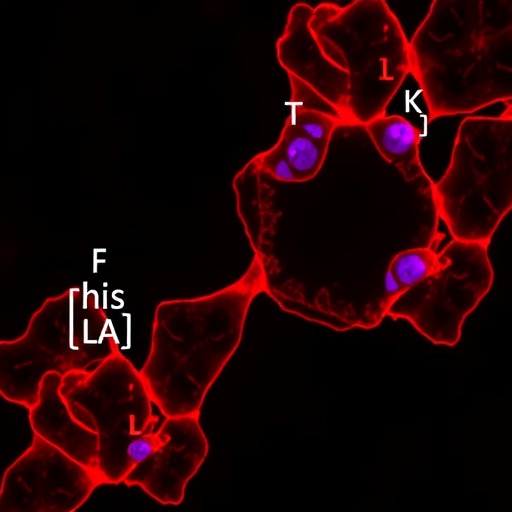Recent groundbreaking research conducted by a team of scientists sheds light on the impact of an Alu insertion on the cellular localization of tissue factor protein, presenting significant implications for our understanding of cellular processes and disease mechanisms. Tissue factor (TF), a key protein in the coagulation cascade, is essential for hemostasis and plays a crucial role in various pathological conditions, including thrombosis and cancer.
The findings, published in the renowned journal Scientific Reports, reveal that the presence of an Alu element—a type of transposable DNA sequence—can markedly alter the localization of tissue factor within the cell. This alteration could potentially influence the protein’s function, leading to critical consequences for cellular signaling and response. The research addresses a fundamental question in molecular biology: how does genetic variation influence protein behavior and, consequently, cellular physiology?
During the study, the research team conducted a series of experiments to investigate how the Alu insertion affects TF’s localization within various cellular compartments. They employed advanced imaging techniques, including fluorescence microscopy, which allowed them to visualize the dynamic behavior of TF in living cells. The results indicated a significant shift in the protein’s localization patterns, suggesting that the Alu insertion introduces a unique regulatory mechanism that may alter TF’s engagement in cellular processes.
Moreover, the team explored the biochemical pathways influenced by the Alu insertion. By examining the interaction of tissue factor with other cellular proteins and lipids, they uncovered new insights into how TF’s localization can dictate its role in cell signaling. This discovery highlights the intricate interplay between genetic elements and protein function—a relationship that is pivotal in understanding complex diseases where tissue factor is implicated.
To further validate their findings, the researchers performed a series of genetic manipulations. By creating cell lines that either expressed or lacked the Alu insertion, they observed striking differences in TF localization and activity. These models provided compelling evidence that even small genetic changes can have profound effects on protein behavior, warranting deeper investigations into the role of similar genetic elements in other proteins.
The implications of this research extend beyond basic science. With tissue factor being a central player in coagulation and cancer progression, understanding how its localization is regulated opens avenues for developing targeted therapies. The findings raise the possibility of novel interventions that could manipulate TF localization to mitigate diseases associated with thrombosis and tumorigenesis.
Additionally, the technological advancements employed in this research underscore the importance of interdisciplinary approaches in modern biology. By integrating molecular biology, bioinformatics, and imaging techniques, the team has set a precedent for future studies aimed at unraveling the complexities of protein dynamics in the cellular environment.
As the scientific community begins to digest these findings, the inquiry into the functional implications of Alu insertions will likely gain momentum. Researchers may embark on similar investigations across various cellular systems, potentially revealing a broader spectrum of biological effects attributed to transposable elements.
In conjunction with this, the implications for personalized medicine cannot be overlooked. Given the variability in genetic elements among individuals, the study paves the way for exploring how genetic predispositions could influence an individual’s susceptibility to diseases associated with tissue factor.
The research’s importance is further amplified by the increasing recognition of the need for a nuanced understanding of genetic contributions to health and disease. As scientists continue to unravel the intricate network of genetic regulation, it is anticipated that revelations like those regarding the Alu insertion will lead to a paradigm shift in how we approach disease treatment and prevention.
In conclusion, the timely findings from Chatterton-Bartley et al. signify a significant advancement in our comprehension of how genetic variations can affect protein localization and function. These insights not only enrich our theoretical understanding but also hold the potential for practical applications in medicine. The prospect of translating these findings into therapeutic strategies remains an exciting frontier for researchers and clinicians alike.
As we await further explorations in this domain, the research stands as a testament to the power of modern science in deciphering the complexities of life at the molecular level. The ongoing dialogue within the scientific community regarding the implications of Alu insertions and other genetic variations is sure to evolve, providing fertile ground for future studies that aspire to enhance human health through tailored medical interventions.
Subject of Research: The impact of Alu insertion on tissue factor protein localization.
Article Title: Impact of an Alu insertion on the cellular localisation of tissue factor protein.
Article References:
Chatterton-Bartley, C., Cao, J., Boyle, J. et al. Impact of an Alu insertion on the cellular localisation of tissue factor protein. Sci Rep 15, 35488 (2025). https://doi.org/10.1038/s41598-025-19280-4
Image Credits: AI Generated
DOI: 10.1038/s41598-025-19280-4
Keywords: Alu insertion, tissue factor, cellular localization, genetic variation, protein dynamics, coagulation, disease mechanisms.
Tags: advanced imaging techniques in molecular biologyAlu insertion effects on tissue factor localizationcellular localization of tissue factor proteincellular signaling influenced by Alu elementsfluorescence microscopy in live cell imagingimpact of genetic variation on protein behaviorimplications for cellular processes and disease mechanismsregulatory mechanisms of protein localizationresearch published in Scientific Reportsrole of tissue factor in coagulation cascadesignificance of tissue factor in thrombosis and cancertransposable DNA sequences in gene expression





